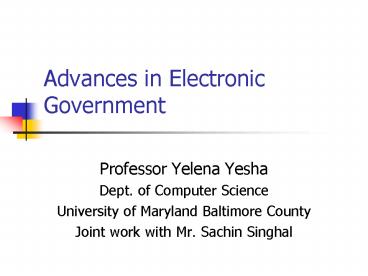Advances in Electronic Government - PowerPoint PPT Presentation
1 / 24
Title:
Advances in Electronic Government
Description:
In the past years, there has been a noticeable shift in the way government is ... Advancing E-Government at the Grassroots: Tortoise or Hare? ... – PowerPoint PPT presentation
Number of Views:74
Avg rating:3.0/5.0
Title: Advances in Electronic Government
1
Advances in Electronic Government
- Professor Yelena Yesha
- Dept. of Computer Science
- University of Maryland Baltimore County
- Joint work with Mr. Sachin Singhal
2
Outline
- Introduction
- Definition and Goals
- Stages of E-Government Development
- Trend Shifts
- Factors and Impacts
- Conclusions and the Future
- Deeds
3
Introduction
- In the past years, there has been a noticeable
shift in the way government is using technology
to provide services and disseminate information. - The change has begun with larger governments and
is slowly moving toward the local and county
organizations which closely interact with
citizens.
4
Introduction
- However, the development of transactions and
online services has been progressing at a slow
pace. - The adoption of web sites is related to
government demographics such as size and region.
5
Introduction
- 1995 -- only 8.7 of local governments had
websites 1 - 1997 40 of the organizations had websites
- 2000 doubled to 83.7 of the organizations
- The level of sophistication is rapidly
increasing. US government spending will rise from
1.5 billion in 2000 to 6.2 billion in 2006. 1
6
Definition and goals
- E-government can be defined by the following
goals - Electronically or Internet-based website
- 24 hours a day seven days a week.
- Distribution of services and information to
citizens.
7
Stages of E-Government development
- This model provides a manner to measure the
development of an organizations structure. - Catalog Users can view or download brochures,
forms, and other static information. - Transactional Possesses the ability to
exchange information with users and accept
payments
8
Stages of E-government Development
- Vertical Integration
- Allow businesses to interact with various
departments from one government to register
electronically. - Horizontal Integration
- Complete transactions with various levels of
government. - Allow businesses to request permits/services
from state and federal governments.
9
Trend Shifts
- E-government organizations have been improving
their structure rapidly. - Since 1995, local governments have been
building their own websites at an exponential
rate.
10
Trend Shifts
- Government organizations are expanding and
improving available services and technologies. - Portals are now available on some sites for
paying bills, filing complaints, and service
requests, etc.
11
Trend Shifts
- 3. Sophistication is out of reach for local
governments. - There is a relationship between government size
and sophistication. Large cities located in the
west and south are at the leading edge of IT.
12
Factors and Impact
- Three different demographics determine government
- Size Larger gt 250,000,
- medium 25,000 to 249,000 and
- small lt 25,000
- Type City versus county/local
- Region Located in east, west, and central.
13
Factors
- Web Site Adoption
- The adoption of websites has rapidly increased
from 8.7 to 83 in 2000 1. - The most sophisticated websites are in large
government cities and counties. - 50 of the local governments have web staff and
25 pf were part time 1.
14
Factors
- Strategic Planning
- Planning is necessary for a valid and effective
development of infrastructure. - While 70 of governments claim to have followed
planning, 90 of local governments had none.
15
Factors
- Strategic Planning
- Speed of evolution the rate of improvement for
e-government is very fast. The majority of
governments are not able to build a plan to meet
the challenges. - Inadequate financial resources and web staff.
- Lack of plan can lead to barrier for deployment
16
Factors
- Perceived Impacts
- Building an E-Government structure has led to a
mixture of positive and negative effects. - The Bush administration has set e-government
spending as 1 of 5 facets in its agenda - Available services such as an IRS tax-filing
application has provided more convenience for
citizens.
17
Factors
- Perceived Impacts
- Increased the demand on government staff
- Altered the roles of staff
- Re-designed government procedures
18
Factors
- Perceived Impacts
- Reduced time constraints
- Lowered administrative costs
- Improved quality of service with businesses
19
Factors
- Providing Transactions
- Most local governments according to a 2002 study
were beyond stage 1 of development 1. - Very few ( lt 3) provided any type of service or
portal. - Current services paying taxes, paying bills,
permit fees, online voting registration
20
Factors
- Barriers of E-government deployment
- Most websites lt 3 years old
- Public organizations require time to develop
services in an IT environment - Few have a dedicated web staff for building and
maintaining an Internet site. - As a result, the information can become obsolete
and is not helpful to the citizen.
21
Factors
- Barriers of E-Government deployment
- Lack of financial resources
- Determining security and privacy issues
- Upgrading existing IT resources.
- A lack of resources can prevent upgrade of the
existing site. Budgets continually fluctuate
based upon current conditions.
22
Conclusions
- While most governments do have a website, most
are still at level 1 of development. - Due to the rapid evolution, more organizations
will move to later stages. - For local governments, e-government can entail
negative aspects due to stretched resources.
23
Conclusions
- Undertake thorough strategic planning to
determine whether it is feasible and would return
positive features.
24
References
- 1 Stephen Holden, Donald Norris, and Patricia
Fletcher. Electronic Government at the Local
Level Progress to Date and Future Issues.
American Society for Public Administration, 2003. - 2 Donald Norris and M. Jae Moon. Advancing
E-Government at the Grassroots Tortoise or
Hare? University of Maryland, Baltimore County.































